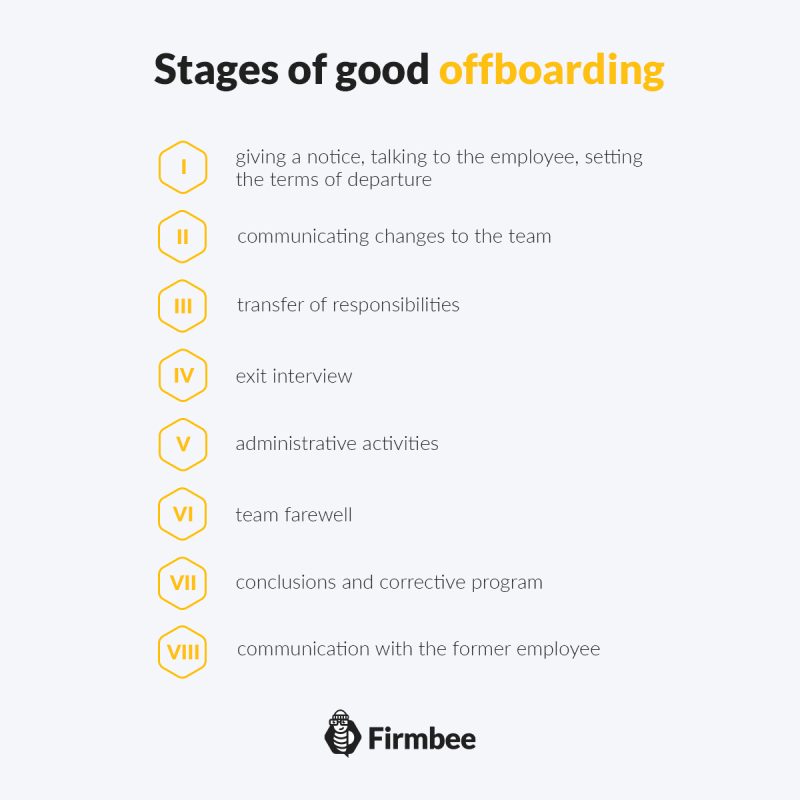Both onboarding and offboarding are essential tools for managing human resources in an organization. Properly carrying out processes related to the adaptation of newly hired people (onboarding) and the departure of employees (offboarding) are key in the design of employment and the effective use of workers’ potential. Properly planned and executed employee offboarding significantly improves the image both inside and outside the organization. That’s why it’s so important to develop appropriate attitudes and procedures related to the dismissal of employees, regardless of the form of termination.
Employee offboarding – table of contents:
What does offboarding consist of?
Offboarding is a set of rules and procedures related to the dismissal of an employee, regardless of whether the employee hand in notice or is fired by the organization. It is a complex and difficult process for both parties, with many issues to keep in mind. We should carry out the employee offboarding procedure taking into account aspects related to maintaining good relations and supporting the departing person, identifying risks to the business and developing proper internal communication.
The goal of offboarding is to minimize the impact associated with the loss of work continuity, as well as to allow the departing employee to complete all current issues in a friendly atmosphere and with support from management and co-workers.

Stages of good employee offboarding
You can’t limit employee offboarding to just talking to the employee about his departure from the company. It is important to remember that this is a process that consists of several stages, and within them a series of actions and activities. It is important not to skip any of the stages are skipped and to carry them out correctly.
- Stage 1 – giving a notice, talking to the employee, setting the terms of departure.
- Stage 2 – communicating changes to the team.
- Step 3 – transfer of responsibilities.
- Stage 4 – exit interview.
- Stage 5 – administrative activities.
- Stage 6 – team farewell.
- Stage 7 – conclusions and corrective program.
- Step 8 – communication with the former employee.
Make sure to conduct the conversation in a friendly manner, without unnecessary tension. It is crucial to determine the date of departure, how duties will be transferred, how leave will be accounted for, and to consider dismissal during the notice of termination.
When one employee leaves, communicating this message to the rest of the team plays an important role. The entire team should get information from the manager regarding personnel changes, the reasons for parting, key dates, how the responsibilities will be transferred and the steps that will be taken for the vacant position.
To maintain continuity of work, the departing employee should be asked to hand over responsibilities and key issues. Including, in particular, the scope of ongoing projects, uncompleted tasks, key contractors both internal and external as well as the access to systems, resources, authorizations and documents.
This is a summary interview conducted with the dismissed employee. It should not be conducted by the immediate supervisor, due to personal relationships that may affect the quality and veracity of the information. The interview can be conducted at any time during the notice period. If the employee has been terminated from his job, this interview makes it possible to obtain knowledge of any irregularities occurring in the organization and the possibility of correcting them. The purpose of such an interview is primarily to gather information on the reasons for dismissal, the level of job satisfaction, motivational tools, interpersonal relations, opportunities for development and evaluation of the company’s image.
Implementation of formalities related to the settlement of leave, certificate of employment, return of business equipment, removal of personal belongings as well as the access to databases and programs.
It is always a good idea to part ways in a friendly atmosphere. For the employee the departure becomes stressful, while the employer keeps good name and reputation.
Summarize the reasons for leaving and identify courses of action to reduce employee-initiated departures in the future. Based on the information gathered, develop and implement a remedy plan.
Maintaining a positive relationship with the dismissed employee can translate into an improved company image and more effective recruitment efforts to attract new talent.

Summary
We should consider offboarding not as a failure, but as a lesson and a pointer to improve the existing inadequacies in the organization. Also, in the case of dismissal on the part of the employer, a properly conducted employee offboarding process minimizes resentment or expression of negative opinions by former employees and will reinforce positive memories and experiences. In addition, it translates into creating positive attitudes toward quitting by indicating that a change of employment is a beginning of a new stage in professional life.
If you like our content, join our busy bees community on Facebook, Twitter, LinkedIn, Instagram, YouTube, Pinterest.
Author: Nicole Mankin
HR manager with an excellent ability to build a positive atmosphere and create a valuable environment for employees. She loves to see the potential of talented people and mobilize them to develop.


















